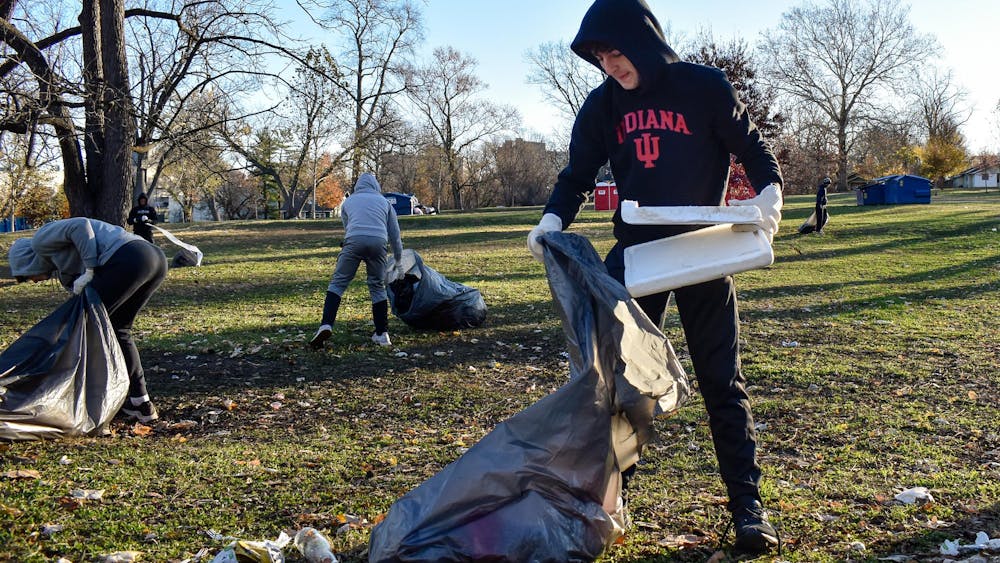Now you can buy a candy bar or a lottery ticket while simultaneously stepping back in time. \nDowntown Bloomington has a new late-night convenience store that provides a glimpse of its history. Inside the Black Mercantile, on the corner of Seventh and Walnut streets, the colors of shiny candy wrappers pop out against red brick walls that have existed for nearly 200 years. Neon signs glow inside windows that look as though they could've been taken out of a black and white movie; outside, you might half expect to see horse-drawn carriages rather than cars.\nMike Black noticed downtown Bloomington lacked a convenience store and he opened the Black Mercantile, or "Black Market." Black also owns the Video Saloon, a bar known to many as "The Vid," located directly above his new store. \n"It gave us a chance to do something besides sell alcohol," Black said.\nThe store opened Aug. 26 after about 11 months of construction and restoration work. It's convenient for students and Bloomington residents alike, open from 8 a.m. to 1 a.m. weekdays and until 2 a.m. on weekends. Black's still testing store hours, waiting to observe customer flows before fixing a permanent schedule. \n"You can't tell the public what they want," he said. "They tell you." \nHe's considering making the store a 24-hour operation, although he suspects business would be bleak from 4 to 6 a.m.\n"Between those hours you could go lay down in the middle of the street and not get hit by a car," Black said.\nOnce he started renovating, Black realized the building below his bar had a lot of history, giving customers a peek of what businesses looked like in the early 20th century. He used maps and photographs of businesses in the area to aid in the design of the restoration project.\nBuilt as a brick house in 1828, the original brick walls are still visible inside the store today. The new storefront was partially designed after a market that stood on the same corner in the 1940s. \nTo recapture the architecture of the early 1900s, the building was literally given a facelift. The entire front of the building was removed, even the doors. Only the support structures remained until the market got an entirely new façade.\nPrevious businesses were built onto the building's original insides, and layers of carpeting and flooring were stacked on top of each other. Tools, which Black compared to ice scrapers, were used to peel away these layers, revealing the wooden floorboards customers walk on today. Black knelt down and moved his hand along the boards to demonstrate they are smooth and splinter-free. \nThe Bloomington Historic Preservation Commission aided in the restoration of the building. It took great pains to preserve the historic feel of the building's design. The most prominent feature of the store's façade is its tall, oblong display windows. It would have been much easier to build the windows with aluminum frames, but the Commission urged the use of wooden frames for authenticity. Black agreed, and the window frames were specially fitted with wood because as he mentioned, the Commission "said please and everything."\nNancy Hiestand, program manager of the Bloomington Historic Preservation Commission, worked with Black to make sure the restoration process accurately echoed downtown Bloomington's architectural history.\n"He was very receptive to our ideas," Hiestand said.\nAs a result of Black's convenience store project, the Bloomington Urban Enterprises Association now offers a $10,000 grant to downtown business owners who want to restore their buildings. Hiestand said the grant was created to give incentive to restore and preserve the history of downtown's architecture. There are very few original storefronts left.\nThe Seventh Street side of the Black Mercantile is still under construction. Upon completion, it will include bay windows, an architectural feature common of downtown Bloomington's historic buildings. \n"They add to (the) uniqueness of Bloomington," Hiestand said.\nBut she lamented that many of these historic windows are covered with siding.\nStudents from Ball State University helped with the restoration process. Ball State has a Center for Historic Preservation as part of its College of Architecture and Planning. The students from the center developed guidelines for restoring the brick, options for painting and ways for the new design to complement the overall style of the building. \nTalisha Coppock, executive director of Downtown Bloomington Commission, said the Black Mercantile is a very important business to add to downtown. The Downtown Bloomington Commission is a non-profit organization that has been working to revitalize the downtown area for the past 20 years.\nCoppock accredited the push for the restoration of downtown to its importance in attracting tourists and improving the local economy. Bringing historic architecture to the surface helps preserve an area which makes Bloomington unique.\nThe Downtown Bloomington Commission's work to improve downtown is part of a statewide effort to preserve history, known as the Indiana Mainstreet Program. The program encourages Indiana towns to improve their downtown business districts. \n"Finding a vibrant downtown is important for the livelihood of the community," Coppock said. "Not every community has a vibrant downtown"
Buying at the 'Black Market'
New downtown store offers convenience, a taste of Bloomington's history
Get stories like this in your inbox
Subscribe





